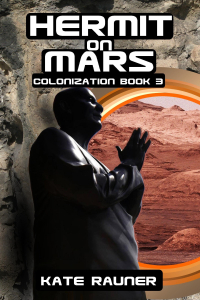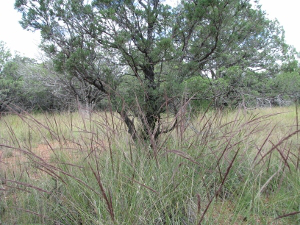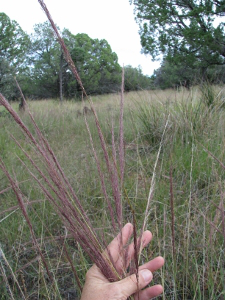Kate Rauner's Blog, page 68
October 7, 2016
Podcasts of Scifi & Fantasy
If you'd like to enjoy a story on your commute or for a break anytime, I bet you'll find something you like.
http://insani-x.com/600-second-saga/
October 6, 2016
Cavern Bats #poem #poetry #nature #findyourpark #bats
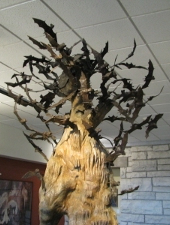
Statue in Carlsbad Visitors’ Center
Rising from the cavern,
As swirling clouds,
As living smoke,
Spiraling up from the pit
Come the bats.
Tourists watch, still and silent.
Bats make no sound,
No chirp nor chatter,
No flap of wings
Comes with the bats.
No group can be silent for long.
Someone coughs,
Whispers,
A baby cries.
Still the bats come.
Feet shuffle
As a few people leave
Beneath the stream of wings.
A cricket trills its evening song.
Still the bats come.
Distant city lights glow,
On a plain beyond the cliffs.
People trickle away
Until less than half remain.
Still the bats come.
I no longer see them
Circling in the pit,
Only their silhouettes
Against the evening sky.
Still the bats come.
Stars begin to shine
High overhead.
The Summer Triangle,
The Northern Cross.
Still the bats come.
Darker now.
Too dark for my eyes
To see a bat against the sky.
I rise. I leave for that city’s glow.
Still the bats come.
By Kate Rauner
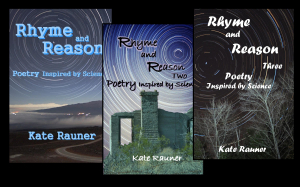 Carlsbad Cavern National Park and the bats’ nightly flight from its enormous natural entrance. All my books, including collections of my science-inspired poetry, are available at Amazon, Barnes & Noble, iTunes, Kobo, and other major online retailers. You’ll also find paperbacks at Create Space and all major digital formats at Smashwords. Read one today.
Carlsbad Cavern National Park and the bats’ nightly flight from its enormous natural entrance. All my books, including collections of my science-inspired poetry, are available at Amazon, Barnes & Noble, iTunes, Kobo, and other major online retailers. You’ll also find paperbacks at Create Space and all major digital formats at Smashwords. Read one today.
Filed under: Poetry Tagged: bats, Carlsbad Cavern National Park, cave's natural entrance, National Parks' Hundredth Anniversary, nature, tourists, wildlife








October 1, 2016
Hermit on Mars #scifi #books #Mars #colonization
Excuse me for crowing, but…
I go the independent route, and there’s a lot of interactive work to get a book published. My rural internet connection isn’t up to it. I spent a day in town – thanks to the public library and Silver City’s coffee shops for their WiFi. That lets me spend hours in concentrated effort, wander around and get a snack, go back to work, and at the end of the day have the book launched.
Every book seems to present me with new errors to make, so inevitably I have to make corrections to the file and re-upload. More than once I’m sorry to say,so when it’s done I feel great.
September 28, 2016
Grass #haiku #nature #poem #poetry #autumn #writing
Seeds like banners raised
Tickling my fingertips
On an autumn stroll
Clouds of purple seeds
Each drop drizzles through my hands
Soon to sleep in snow
Filed under: Poetry Tagged: autumn, fall, haiku, nature, poem, poetry, Wild grass seed








September 24, 2016
Biofilms Coat Monuments – Good or Bad or Both? #archeology #biology #art #science
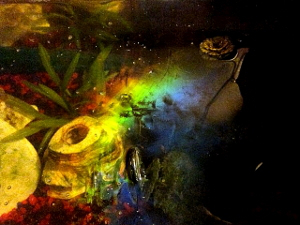
An iridescent biofilm on the surface of a fish tank.
Biofilms are everywhere – miniature ecosystems of bacteria, algae, and fungi – inside your gut, on the surface of the ocean, and colonizing the monuments of human civilizations old and new.
The Jefferson Memorial is developing a suntan as the gel-like film produces protective pigments.
Snowy white monuments and edifices in Washington, D.C., were built to link the American experiment with its Greek and Roman muses. Crafted from pure, unstained marble, the city’s classical architecture is a visual representation of the nation’s pursuit of civic ideals”
This is ironic, since the Greek and Roman statues that inspired America’s Founding Fathers were only white because of their age. Originally, most were painted in bright colors. But I can’t claim the dark blotches reproduce such color – in Washington DC, Italy, Egypt, or Cambodia, where other cultural treasures are under attack.
Or, maybe not. Maybe the films are protective.
The answer, at best, is unclear. But the white surfaces of the newer American monuments are a clean slate for observing how biofilms develop, grow, and spread and so are a valuable experimental research ground for helping clarify how biofilms may be damaging—or protecting—the world’s great historic stone monuments.”
That’s not the only question. New biofilms are appearing on ancient monuments – why now? Some people think that reducing air pollution, at least in the US, has stopped acid rain from scrubbing the stones. Increased humidity from thousands of tourists breathing may explain the growth at other sites.
Science will work to understand what’s happening, but how our aesthetics evolve is another story. Will our descendants someday think we’re as crazy to want white marble as we think ancient Romans were to paint their statues in garish colors?
Thanks to nationalgeographic.com for their article and the quotes above.
Filed under: Neat Science News Tagged: algae, ancient monuments, and fungi, biofilm, ecosystems of bacteria, Greek and Roman statues, Jefferson Memorial








September 21, 2016
The Ape That Cooks #poem #poetry #nature #evolution #human
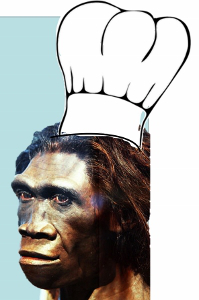
Homo erectus – the first cook. Hall of Human Origins in the Smithsonian Museum of Natural History in Washington, D.C. (except for the hat)
We are the hunting ape,
But other apes do hunt.
We are the speaking ape,
But other apes do grunt.
What set us on the path
To our enormous brain?
And brought us down
From the trees
To walk across the plain?
We are the ape with fire!
There’s evidence to show
Prometheus brought us his gift
A long long time ago.
With fire, sleeping on the ground,
Protected from the lions,
We shed our dense and furry coats,
It warmed us through the nighttime.
While other apes use their day
To chew and chew and chew
Their tubers, leaves, and wild fruits
We cooked the first fast food.
This new step in digestion
Meant more calories,
Cooked out the germs and toxins
Of wild plants and meats.
Tied to our adaption,
We’d never be the same.
“We are the cooking apes,
The creatures of the flame.”
I recently read Catching Fire, How Cooking Made Us Human by Richard Wrangham. I was happily surprised at how fascinating his hypothesis is: that starting as long ago as Homo erectus, humans evolved with fire and cooking. There are lines of evidence I would have never thought about – delightful.
Wrangham is really involved in his subject. He knows how much effort it takes to chew raw wild foods because he’s studied chimpanzees and tried their various foods. With some friends he ran an informal experiment chewing raw goat meat. They found that adding old leaves to their mouths – as chimps do when they eat meat – gave their teeth more “traction” to get the (nasty sounding) mess down.
He also covers a lot of related topics, including raw foodists and modern hunter-gatherers. It’s a great book.
Thanks to Wrangham for the final quote in the poem above.
 All my books, including collections of my science-inspired poetry, are available at Amazon, Barnes & Noble, iTunes, Kobo, and other major online retailers. You’ll also find paperbacks at Create Space and all major digital formats at Smashwords. Read one today.
All my books, including collections of my science-inspired poetry, are available at Amazon, Barnes & Noble, iTunes, Kobo, and other major online retailers. You’ll also find paperbacks at Create Space and all major digital formats at Smashwords. Read one today.
Filed under: Poetry Tagged: cooking, evolution, fire, great apes, homo erectus, how did humans evolve, why did humans lose their furry coat, why do humans have big brains








September 18, 2016
Science and Engineering at Your Fingertips #innovation #tech #science #engineering
Isn’t science all about stars and black-holes type stuff?”

Carlos Delgado; CC-BY-SA
There’s so much more, and we encounter it every day in so many ways. Take, for example, a ball point pen. It’s a fairly recent invention. You’ve seen the iconic pocket protector worn by Dilbert and engineers everywhere. Do you remember them? They were needed before ball point pens because fountain pens leak.
The first patent was filed in 1888, but it took years and a lot of failure before our familiar pen emerged. Different pen designs and different inks were tried. In 1941, a fleeing German and his associates (the Western Hemisphere didn’t just get nuclear physicists from Germany because of the Nazi!)
Early ball point pens had problems – the ink would hang up and the pen become unusable. This happened all the time. There was also a safety issue – people like to chew on the ends of pens and a swallowed cap could choke someone. Such an accident might be rare, but consumers don’t expect their pens to kill anyone.
A brilliant engineering solution came across the creative mind of scientists, and a newly innovated cap was introduced into the market which enables the nib to breathe in air, helps in regulation of air pressure [inside the pen] to match the air pressure outside, and to avoid death in people who accidentally swallow the cap. Yes, the innovation in design was just a hole being placed on top of the caps.”
Competition was fierce but it wasn’t until well into the 1950s that pens “boasting additional features and technological advances which also included the use of tungsten-carbide textured ball-bearings in their pens” [wikipedia] began to sell in the millions each year – and familiar names such as Parker and Bic emerged. Today ball point pens are so cheap we tend to walk off with them without thinking, and loads of businesses hand them out for free as advertising.
How cool.
Thanks zainsofficial.blogspot.com for pointing out this miracle of modern science, and for the quotes above.
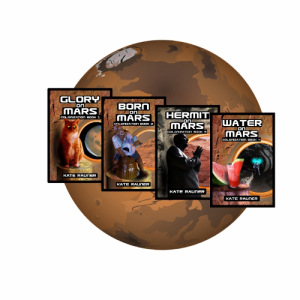 Our world is full of amazements we take for granted. Consider the fantastic logistics behind the pencil. I found inspiration there for my science fiction novel Glory on Mars. What fantastic technologies will the first colonists haul to Mars? And what common conveniences will they leave behind?
Our world is full of amazements we take for granted. Consider the fantastic logistics behind the pencil. I found inspiration there for my science fiction novel Glory on Mars. What fantastic technologies will the first colonists haul to Mars? And what common conveniences will they leave behind?
All my books, including the On Mars series, are available at Amazon, Barnes & Noble, iTunes, Kobo, and other major online retailers, including Smashwords and Create Space for paperbacks. On Mars books 1 and 2 are available now, with books 3 and 4 due out this fall. Read one today.
Filed under: Neat Science News Tagged: #technology, ball point pen, conveniences, engineering, modren world, pencil, science








September 14, 2016
Creating Earth and Moon #poem #poetry #space #Moon #solarsystem
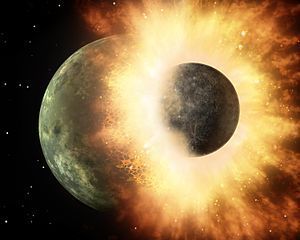
Did Theia and proto Earth’s mantle vaporize and merge?
Terrestrial and lunar rocks
Share similarities,
The isotopes of elements
Found in both of these.
Early in the solar system,
When proto-worlds collide,
Such isotopic matching
Is hard to reconcile.
New research seeks a better scheme
And everyone is trying,
Potassium in rocks may show
Which models are complying.
Perhaps the rogue colliding spheres
Vaporized Earth’s mantle
To atmospheres of gaseous rock,
Of fluids supercritical.
Then Earth and Moon, upon their face,
Would match in just this way.
Their composition now makes sense
At least, it does today.
By Kate Rauner
 Thanks to space.com for their article on the birth of the Moon, and to Kun Wang (Washington University) and Stein Jacobsen (Harvard) for their findings online September 12 in the journal Nature. The Mars-sized rock that collided with Earth is called Theia, named for the mother of the Moon in Greek myth, but I just couldn’t work that into the poem[image error]Where did the moon come from
Thanks to space.com for their article on the birth of the Moon, and to Kun Wang (Washington University) and Stein Jacobsen (Harvard) for their findings online September 12 in the journal Nature. The Mars-sized rock that collided with Earth is called Theia, named for the mother of the Moon in Greek myth, but I just couldn’t work that into the poem[image error]Where did the moon come from 







September 10, 2016
It’s a Scottish Loch – it’s a monster – no, not that one #monster #Scotland #fossil #biology
I understand why we hate to say such a creature no longer swims in Earth’s waters.
Scientists have unveiled a monster that would make Nessie blush: a 13-foot-long reptile that
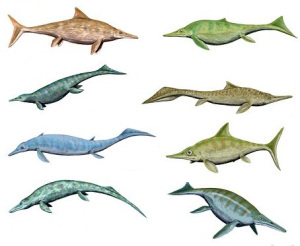
Various ichthyosaurs
ruled the seas 170 million years ago… the Storr Lochs Monster.”
The ichthyosaur was a predator, a fast marine reptilian that excites our imaginations – and hopes. Sort of a Jurassic dolphin, though not a mammal. Suppose you could discover such a creature – even as a fossil.
An amateur fossil collector … noticed something strange jutting out of the rocks: strings of vertebrae that looked like stacks of chocolate-brown ashtrays.”
Sadly the discoverer died before the fossil was extracted from the very-hard rock matrix that held it. I wonder what he saw when he closed his eyes and imagined his fossil swimming through ancient seas?
I usually think of the cryptid Nessie as more of a serpent – ling and thin – that decades of searching has failed to find. Better a fossil in the hand.
Thanks to nationalgeographic.com
Filed under: Neat Science News Tagged: citizen scientist, fossil, ichthyosaur, Isle of Skye, Jurassic era, Loch Ness Monster, Storr Lochs Monster








September 7, 2016
Starlight Speaks – #star #science #space #poem #poetry
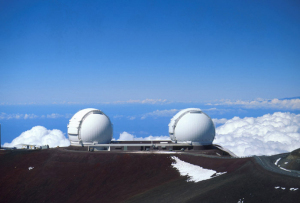
The twin Keck Telescopes atop Mauna Kea, Hawaii
Everything we know
About the universe
Comes from feeble twinkles that
Speak grandly when observed.
When does the light arrive,
And comes from what direction?
How intense or diffuse
Are colors from refraction?
Light presents a barcode
Of dark lines to be read
Across the vibrant spectrum
From UV to infrared.
As starlight travels to the Earth
Each atom in the way
Leaves its mark within the beam
As photons fly away.
And so we know how far’s the star
How fast it moves by us,
If planets orbit ’round its disk
And what its core is made of.
by Kate Rauner
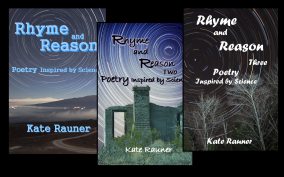 Thanks for a wonderful explanation of how astronomers use starlight at fivethirtyeight.com
Thanks for a wonderful explanation of how astronomers use starlight at fivethirtyeight.com
All my books, including collections of my science-inspired poetry, are available at Amazon, Barnes & Noble, iTunes, Kobo, and other major online retailers. You’ll also find paperbacks at Create Space and all major digital formats at Smashwords. Read one today.
Filed under: Poetry Tagged: how do we know about stars, poem, poetry, spectrograph, spectrum, star, starlight









